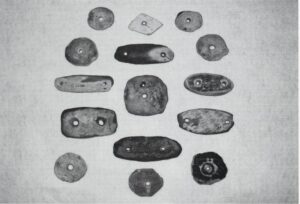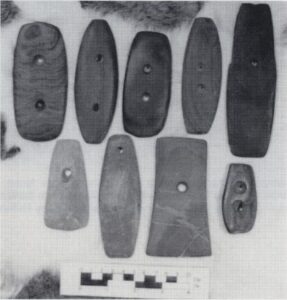Are you familiar with the intriguing world of gorgets? Whether you’re an antique collector, a history buff, or simply curious about unique fashion accessories, this article is here to uncover the secrets of gorgets and provide you with everything you need to know about these fascinating adornments.
From their origins in medieval times to their continued significance in contemporary fashion, gorgets have captured the attention and fascination of many. But what exactly is a gorget? How were they used in the past and what role do they play today?
In this comprehensive guide, we will explore the history, symbolism, and various uses of gorgets. Delve into the different types of materials used, the intricate designs that showcase both craftsmanship and personal expression, and how to spot authentic gorgets in the market.
Join us as we unveil the mysteries of a gorget, shedding light on its cultural significance and offering insights into its enduring allure. Whether you’re a seasoned collector or just starting to explore, this article is your trusted companion in unraveling the captivating world of gorgets.
History and Significance of Gorgets
Gorgets have a fascinating history that traces back to medieval times when they were worn as part of armor to protect the throat during battle. Over time, gorgets evolved from functional pieces into decorative accessories, symbolizing status, power, and elegance. In the 17th and 18th centuries, gorgets became popular among military officers and aristocrats, embellished with intricate designs and precious metals to showcase wealth and rank.
The significance of gorgets extended beyond mere fashion, with different styles and motifs representing various meanings. For example, a gorget adorned with floral patterns might symbolize beauty and nature, while one embellished with heraldic symbols could denote allegiance to a particular family or clan. Understanding the historical context and symbolism behind gorgets adds depth to their allure and makes them more than just ornamental pieces.
Gorgets have also played a role in ceremonial traditions, with some cultures using them as part of formal attire for special occasions or rituals. The intricate detailing and craftsmanship that goes into creating a gorget reflect the artisan’s skill and dedication to producing a piece that is not only aesthetically pleasing but also carries cultural significance. As the world evolved, so did the styles and uses of gorgets, adapting to new trends while preserving their timeless appeal.
Different Types of Gorgets
There are various types of gorgets, each with its unique style and purpose. From the classic metal gorgets of the medieval era to the more contemporary fabric or beaded gorgets, these accessories come in a wide range of designs to suit different tastes and occasions. Metal gorgets, often made of silver or gold, are reminiscent of the armor pieces worn by knights and soldiers, exuding a sense of strength and tradition.
Fabric gorgets, on the other hand, offer a softer and more versatile option, allowing for intricate embroidery, beadwork, or embellishments that add a touch of elegance to any outfit. These fabric gorgets can be worn as standalone accessories or paired with other jewelry to create a layered look that is both stylish and sophisticated. Whether you prefer a bold statement piece or a subtle accent, there is a gorget style to suit every taste.
In addition to metal and fabric gorgets, there are also leather gorgets that offer a more rugged and contemporary aesthetic. Leather gorgets are popular among those who appreciate a fusion of traditional craftsmanship with modern design elements. The versatility of gorgets allows for endless creativity in how they are worn and styled, making them a favorite accessory for fashion enthusiasts and collectors alike.
Materials Used in Making Gorgets
The materials used in making gorgets play a crucial role in determining the overall look, feel, and quality of these accessories. Traditional metal gorgets are often crafted from materials like silver, gold, brass, or bronze, with intricate engravings and embellishments adding a touch of luxury and sophistication. These metal gorgets are prized for their durability and timeless appeal, making them valuable pieces for collectors and enthusiasts.
In contrast, fabric gorgets rely on a diverse range of materials, including silk, velvet, lace, or chiffon, to create intricate patterns and designs that evoke elegance and charm. Beaded gorgets, made with glass beads, pearls, or semi-precious stones, offer a dazzling display of color and texture, adding a touch of glamour to any outfit. The choice of materials used in making gorgets can vary depending on the desired style, from vintage-inspired pieces to modern and eclectic designs.
Leather gorgets introduce a more contemporary twist to traditional designs, with materials like cowhide, sheepskin, or suede lending a rugged and edgy look to these accessories. The versatility of leather allows for unique textures, finishes, and colors that appeal to those seeking a statement piece with a modern flair. Whether crafted from metal, fabric, or leather, gorgets showcase the artistry and creativity of skilled artisans who bring these accessories to life with meticulous attention to detail.
How Gorgets Are Worn
The versatility of gorgets allows for a myriad of styling options, making them a versatile accessory that can elevate any outfit. Depending on the design and material of the gorget, it can be worn in various ways to suit different occasions and personal preferences. Metal gorgets, with their bold and structured designs, are often worn as standalone pieces that make a statement on their own.
Fabric gorgets offer a softer and more romantic look, draping elegantly around the neck to add a touch of sophistication to both casual and formal ensembles. These fabric gorgets can be tied in different styles, such as a loose knot, a bow, or a simple drape, allowing for versatility in how they are worn. Beaded gorgets, with their intricate patterns and shimmering embellishments, are perfect for adding a touch of glamour to evening wear or special occasions.
Leather gorgets bring a touch of edge and modernity to any outfit, whether paired with a casual ensemble for a chic daytime look or layered with other jewelry for a bold and eclectic style. The key to wearing a gorget with confidence is to experiment with different styles and combinations to find what works best for your personal aesthetic. Whether you prefer a classic and understated look or a bold and avant-garde statement, gorgets offer endless possibilities for expressing your individuality through fashion.
Symbolism and Cultural Significance of Gorgets
Gorgets have long been associated with symbolism and cultural significance, reflecting the values, beliefs, and traditions of the societies in which they originated. From the intricate designs that adorn these accessories to the materials used in their creation, gorgets carry layers of meaning that go beyond mere adornment. Symbolism plays a crucial role in the design and wearing of gorgets, with each motif and pattern holding a specific significance.
In some cultures, gorgets are passed down from generation to generation, symbolizing heritage, lineage, and familial connections. The act of wearing a gorget can be a way to honor one’s ancestors and carry on traditions that have been passed down through the ages. Additionally, gorgets have been used in various rituals and ceremonies to mark important milestones or events, serving as talismans of protection, prosperity, or love.
The cultural significance of gorgets extends to their role in storytelling and expression, with each piece embodying a narrative that speaks to the wearer’s identity and experiences. Whether worn as a symbol of strength, beauty, or spirituality, gorgets serve as a form of self-expression that transcends fashion trends and societal norms. By understanding the symbolism and cultural significance of gorgets, we can appreciate the depth and complexity of these accessories as more than just decorative items, but as artifacts of history and tradition.
Collecting and Preserving Gorgets
For collectors and enthusiasts, gorgets hold a special allure that goes beyond their aesthetic appeal. Collecting gorgets allows individuals to delve into the rich history and craftsmanship of these accessories, acquiring pieces that tell stories of bygone eras and cultural traditions. Whether collecting vintage gorgets from specific time periods or seeking out contemporary designs that push the boundaries of fashion, the joy of collecting lies in uncovering unique pieces that resonate with personal tastes and interests.
When it comes to preserving gorgets, proper care and maintenance are essential to ensure these accessories retain their beauty and integrity over time. Metal gorgets should be stored in a dry, cool place to prevent tarnishing, while fabric gorgets should be kept away from moisture and excessive sunlight to avoid fading or damage. Beaded gorgets require gentle handling to prevent beads from becoming loose or falling off, while leather gorgets benefit from conditioning to maintain their suppleness and luster.
In addition to physical preservation, documenting the provenance and history of gorgets can add value to a collection, providing insight into the origins and significance of each piece. Whether collecting gorgets as a hobby or investment, the passion for these accessories lies in the stories they tell and the craftsmanship they embody. By preserving gorgets for future generations, collectors contribute to the legacy of these unique accessories and ensure their continued appreciation in the world of fashion and art.
Conclusion: Appreciating the Beauty and Craftsmanship of Gorgets
As we come to the end of our journey through the world of gorgets, we are reminded of the beauty and craftsmanship that make these accessories so special. From their origins in medieval armor to their evolution as fashion statements, gorgets have stood the test of time, captivating generations with their elegance and allure. Each gorget tells a story of tradition, culture, and individual expression, reflecting the values and beliefs of the wearers who adorn them.
By delving into the history, symbolism, and significance of gorgets, we gain a deeper appreciation for these accessories as more than just fashion adornments but as artifacts of human creativity and ingenuity. Whether collecting gorgets for their historical value, wearing them as a form of personal expression, or simply admiring their beauty, these accessories continue to enchant and inspire us with their timeless appeal. As we unveil the mysteries of a gorget, we are reminded of the enduring legacy and allure of these exquisite neck pieces that have captured the hearts and imaginations of people around the world.





